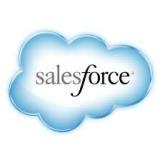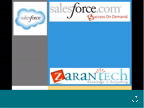60-70 hours to complete both the tracks on 2+ hrs daily session, spread over the week and weekends, totally customisable based on the requirement. FYI...I have been training for the last 7.5+ years and have a very good success rate. I have trained teams from IBM, HCL and many more corporate organisations, both domestic and overseas. There are other capsules based on the type of training module-regular vs. fast paced track, group training, individual-on job support-all customised to suit to the needs of our clients.
Topics Covered
COURSE CONTENTS : TRACK I :Objective Identity Confirmation • Activate your computer • Setting Up the User Interface • Set up the UI & search options • Organization Administration • Set your organization’s language & locale • Manage currency • Customization • Create custom profiles & custom fields • Define dependent picklists • Customize lookup fields & formula fields • Customize page layouts • Customize standard related lists • Learn about record types & business processes • Use field-level security • Security & Access • Create & manage your users • Set organization-wide defaults • Learn about record access • Create the role hierarchy • Learn about the sharing model • Manually share records • Set up opportunity team selling & account teams • Learn about folder access • Workflow • Define workflow • Set up workflow rules • Set up workflow tasks & alerts • Workflow Approvals • Plan approvals using workflow • Use the approval wizard – standard vs. jump-start • Create workflow approvals • Data Validation • Learn about Salesforce CRM data validation • Create data validation rules • Learn about custom fields & unique properties Data Utilities • Import records using the import wizards • Use mass delete • Use mass transfer • Learn about storage utilization • Analytics • Create custom reports • Use advanced filters • Use conditional highlighting • Use custom summary formulas • Create dashboards • The AppExchange • Learn about the AppExchange • Install an app • Uninstall an app • Marketing Administration • Use the integrated campaign builder • Learn about lead queue & lead assignment setup • Learn Web-to-lead & auto-response rules • Service & Support Administration • Learn about cases & solutions • Set up case escalation rules • Identify solution categories & suggested solutions Salesforce Console • Navigate the Salesforce Console • Create a Salesforce Console • Extending Salesforce CRM • Learn about custom objects • Learn about custom tabs • Learn about custom Web tabs • Build a custom app TRACK II : Designing Applications on Force.com • Learn about factors to consider when building a data model • Develop custom objects and fields, encrypted fields, field help, and field history tracking • Use master detail, lookup, and many-to-many relationships • Create a user interface for custom applications using the Custom Object tab, Page Layout, and • Customization options • Set field attributes on the page layout • Use the Custom Object queue and event-based workflow rules with field update actions • Develop custom formulas and validation rules • Designing Applications for Multiple Users • Learn about factors to consider when designing applications for multiple users • Create profiles, understand what a profile controls (including data access), and customize profiles to manage the user experience • Customize the user experience with record types and page layouts • Control access to records • Employ OWD, sharing rules and levels, roles, public groups, and manual share • Apply profiles, OWDs, role hierarchy, and sharing to restrict access to sensitive data • Apply OWDs, public groups, and manual sharing to create conditional access to data • Analyze suitability of FLS, page layouts, and record types to satisfy business requirements • Implementing Business Processes • Use the vlookup, regex, ischanged, isnew, and priorvalue functions to build business processes • Use validation rules to enforce conditional required behavior • Use functions to enforce data format and data consistency • Implement multistep approval workflows and escalations to automate business processes • Create parallel approval workflows and workflow approvals with dynamic approval routing • Use outbound messages as part of an approval workflow • Establish approval workflow criteria with crossobject formulas • Set up field history tracking to audit processes • Learn techniques to prevent or record data changes Managing Data • Learn when and how to use upsert • Use data management tools and the capabilities of API-based tools • Configure the Data Loader via command line • Encrypt passwords using encrypt.bat • Use the Data Loader to create mapping files and to upsert data Visualforce Pages • Learn about the capabilities of the Visualforce framework • Incorporate Visualforce pages into Salesforce Construct expression bindings and incorporate • Salesforce into Visualforce pages with Visualforce tags • Use Visualforce tags to create page layouts,input forms, output tables, custom components; • Create partial page refreshes on JavaScript events • Learn about the functionality that comes with Visualforce standard controllers • Find out when Apex is required for creating custom controllers or extensions
Who should attend
Those who aspires to be -- Salesforce DEVELOPERS/ ADMINISTRATORS/ CONSULTANTS. -- Salesforce TRAINERS.
Pre-requisites
The attendees should have: Sound knowledge in OOPs concepts. Worked in any web based applications. Knowledge in either Java, C++ or C#. SQL/PLSQL experience. Hands on in any IDE like Eclipse, IntelliJ, MS Visual Studio, etc.
What you need to bring
Good configured system/ Laptop Data Card/ Internet Connection
Key Takeaways
Basic Knowledge on CRM & Cloud Computing. Salesforce.com Configuration. Force.com Development Platform. Custom Development using Apex Classes/Triggers & Visualforce.





 14-12-15 11.08 pm-00001.png)





